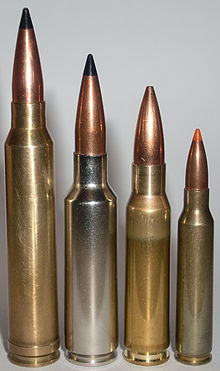Bottle neck sleeve
A cartridge case that tapers at the front is called a bottle neck sleeve . It forms the locking distance on the case shoulder.
The energy of a projectile depends on the size of the propellant charge, which is why the cases of the black powder cartridges were lengthened before the appearance of smokeless powder in order to increase the muzzle velocity of the projectiles. With the advent of small-caliber repeating rifles, this solution became problematic, long cartridges require a long breech, which leads to unwieldy and heavier weapons. In addition, there is a tendency that the charge no longer ignites evenly if the powder chamber is too long, which leads to missed shots.
Modern cartridges, especially high-performance rifle cartridges, are therefore designed in the shape of a bottle because of the propellant charge required . At 1.4 times the case diameter in relation to the caliber, the cross-sectional area is roughly doubled, and with it the loading volume. The sleeves can therefore be made correspondingly shorter for the same performance. There are limits to the increase in volume due to the increase in the cross section of the sleeve, since the increase in cross section leads to turbulence on the sleeve shoulder.
Handguns
In military handguns, only cartridges with bottle necks are used today; the last military rifle to fire ammunition with cylindrical cases in World War II was the American M1 carbine .
Bottle-neck cartridges are also used almost exclusively in hunting today, only older calibres, certain closed- season calibers and large game cartridges such as the .458 Winchester Magnum still have cylindrical cases.
Handguns
Self-loading pistols
Bottle neck sleeves have a decisive advantage over cylindrical sleeves in handguns: the shape of the sleeve makes it easier to insert it into the chamber. For this reason, the cartridges of the first self-loading pistols were exclusively bottle neck cartridges , such as. B. the 7.65 × 25 mm Borchardt (1893), the 7.63 mm Mauser cartridge (1896) and the 7.65 × 21 mm Luger (1900). They found only one successor in the military field, the Soviet 7.62 × 25 mm cartridge (1930) based on the 7.63 mm Mauser . When the first self-loading pistols were developed in the USA, their developers used cylindrical cartridges "for reasons unknown". The cartridges of the Automatic Colt Pistol series were formative for many other developments. Today only a few bottle neck pistol cartridges are manufactured, examples being the .357 SIG and the .400 Corbon .
revolver
Even Revolver are not suitable for bottle-necked cartridge, since these deform during firing, d. H. expand in length and thereby block the drum. For this reason, the Smith & Wesson Model 53 Magnum Revolver for the .22 Remington jet cartridge, launched in 1961, was not a success. Its production was therefore stopped again in 1974.
Weapons with delayed mass locking
In the case of weapons with a delayed mass seal, such as the German HK G3 and the Swiss Assault Rifle 57 , the slide and cartridge base return immediately after ignition with the pressure build-up in the cartridge case. At the same time, the tapering front part of the sleeve is pressed forward and blocked by the gas pressure. In order to avoid case tears, pressure compensation grooves must be present in the front tapering part of the cartridge chamber. The internal pressure on the sleeve cone is thus compensated.
Bottle neck sleeve : 5.56 × 45 mm NATO ( projectile - cartridge case - entire cartridge )
literature
- Thomas J. Hayes, Professor of Ordnance and Gunnery, US Military Academy (Retired): Interior Ballistics . In: Elements of Ordnance . 11th edition. John Wiley & Sons, Inc. Time Inc Book Company, New York 1938, p. 68 ff . (1953).
- Jane's Infantry Weapons . Jane's Publishers Limited, London 1976, ISBN 0-354-00531-6 .
- Roy G. Jinks: Smith & Wesson - a company with a history . Stocker-Schmid, Dietikon-Zurich 1979, ISBN 3-7276-7025-8 .
Individual evidence
- ↑ Form of cartridge cases. In: all4shooters.com. Retrieved October 28, 2017 .
- ↑ Handgun Bottlenecks. In: americanrifleman.org. Retrieved October 28, 2017 (English).
- ↑ Bottleneck Cartridges. In: personaldefenseworld.com. Retrieved October 28, 2017 (English).
Web links
- Form of cartridge cases. In: all4shooters.com. Retrieved October 28, 2017 .



